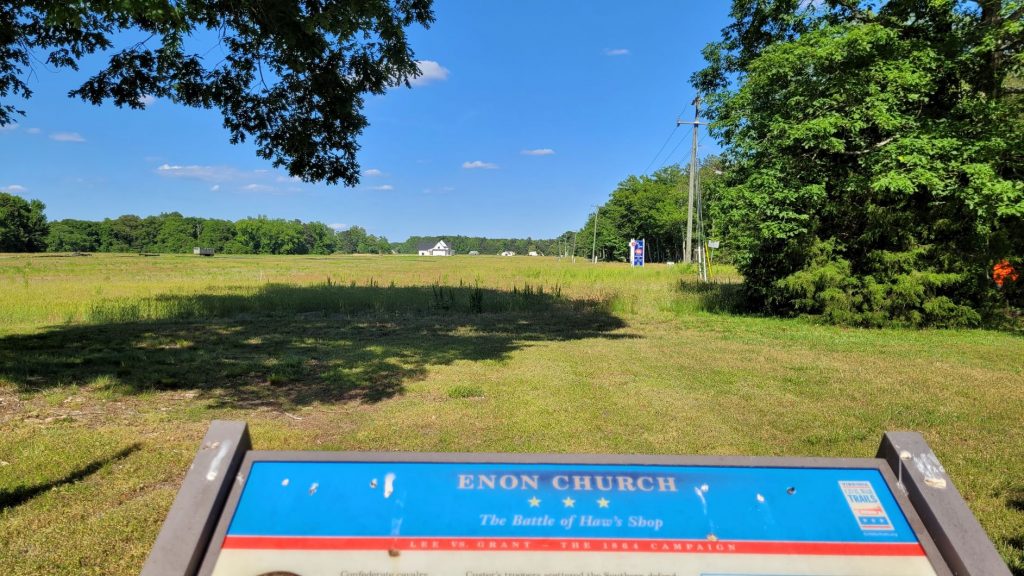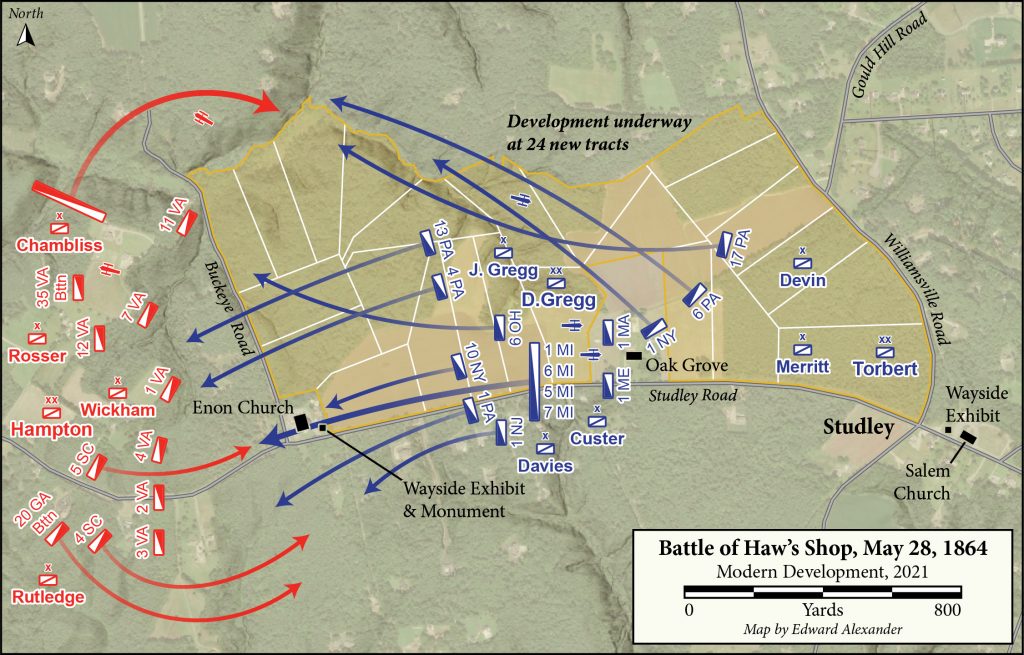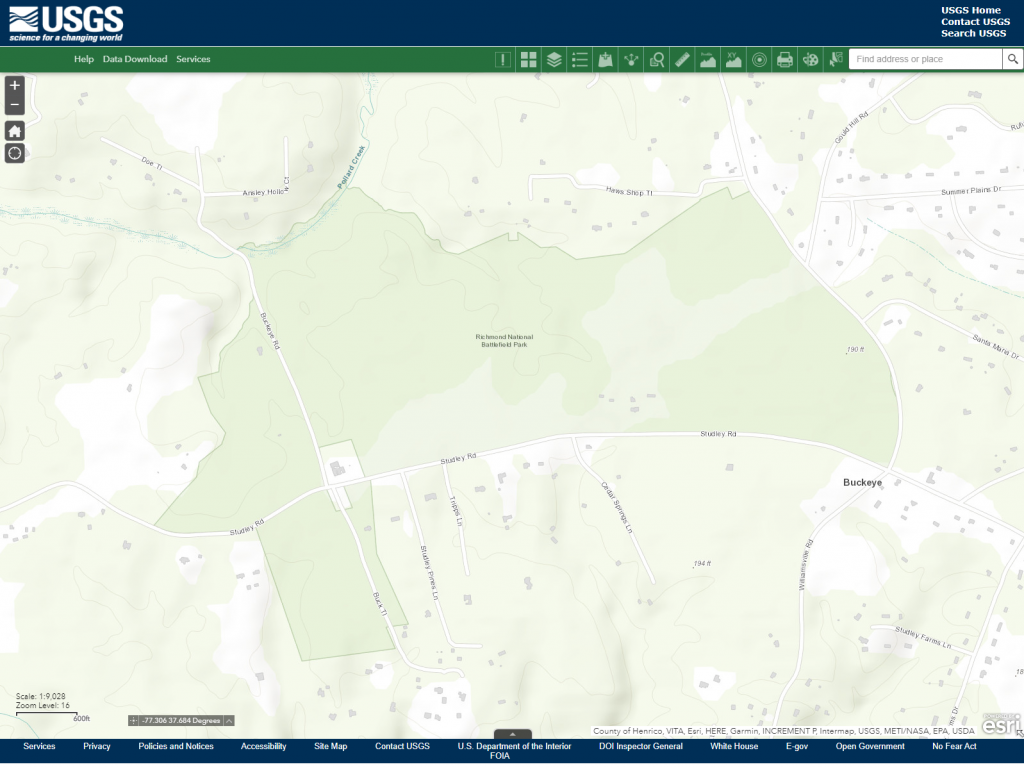Preservation Setback at the Haw’s Shop Battlefield
 In a February 2019 testimony before a congressional subcommittee, American Battlefield Trust president Jim Lighthizer warned that “in the next decade, most unprotected battlefield land will be either developed or destroyed.” Sadly, just over a year later his prediction has proven true on the largest, previously intact parcel of the Haw’s Shop battlefield. From rumblings on how the development played out, the Trust or any other preservation organization would have had a sizeable challenge in protecting the historic landscape. The likely outcome demonstrates the urgent need for preservation advocates to remain aware of potential harm to battlefields in their locale.
In a February 2019 testimony before a congressional subcommittee, American Battlefield Trust president Jim Lighthizer warned that “in the next decade, most unprotected battlefield land will be either developed or destroyed.” Sadly, just over a year later his prediction has proven true on the largest, previously intact parcel of the Haw’s Shop battlefield. From rumblings on how the development played out, the Trust or any other preservation organization would have had a sizeable challenge in protecting the historic landscape. The likely outcome demonstrates the urgent need for preservation advocates to remain aware of potential harm to battlefields in their locale.
As Grant’s and Lee’s armies slowly slugged their way south from the Rapidan to the James, their cavalries also engaged one another with the same fierce consistency that is associated with the Overland campaign. During May alone, Phil Sheridan’s mounted corps battled Jeb Stuart and then Wade Hampton at Todd’s Tavern, Yellow Tavern, Meadow Bridge, Hanovertown, Haw’s Shop, Matadequin Creek, Hanover Court House, and Cold Harbor.
The fighting on May 28th west of Haw’s Shop marked the bloodiest cavalry battle since Brandy Station, almost a year prior. While Grant’s infantry prepared to surge across the Pamunkey River and Lee raced south from the North Anna to block the direct route to Richmond, Sheridan’s and Hampton’s troopers probed at one another throughout Hanover County. Both cavalry commanders sought to use the Atlee Station Road on May 28th and a brisk mid-morning skirmish between several battalions turned into a large-scale affair involving most of nine different brigades.
Beginning the engagement with only the Virginians under Williams Wickham and Thomas Rosser on hand, Hampton dismounted his Confederate cavalrymen and sprawled their battle line perpendicular to the Atlee Station Road west of Enon Church. Hampton anchored the flanks along Pollard and Mill Creeks and mulled taking the offensive. Meanwhile David Gregg summoned artillery to assist his Federal division and prepared to advance along the main road.
For four hours dismounted blue and gray troopers volleyed at one another from proper lines of battle. Occasional mounted charge threatened to tip the scales, but reinforcements evenly stabilized the lines on opposite sides of Enon Church. In an effort to outflank the tighter Union position along the road, Hampton swung Huger Rutledge’s South Carolinians and Georgians south of Wickham’s line and deployed John Chambliss’s Virginians above Pollard Creek. The arrival of Alfred Torbert’s division to reinforce Gregg negated these maneuvers.
At 4 p.m., while both sides jockeyed for position on the flanks, Custer’s Michigan brigade stormed directly west along the road, slamming into the Confederate line behind Enon Church. This determined movement forced Hampton to begin withdrawing his men, leaving the Federals in control of the battlefield. Nevertheless, the Confederate commander afterward claimed that he had fulfilled objective of gathering the intelligence necessary to inform Lee’s decision of where next to interrupt Grant’s maneuver–Totopotomoy Creek.
The one day of cavalry fighting produced over 700 casualties, slightly more of which were among Hampton’s Confederates. Wounded Union soldiers were taken to the home of John Haw, Oak Grove. Haw had operated a shop manufacturing farming and milling machinery, but the Seven Days battles convinced him to sell the equipment to the Tredegar Iron Works. The Haw family remained at Oak Grove until the 1950s while the area around the former shop developed into the small community of Studley, named after the nearby site where Patrick Henry was born in 1736.
Today Hanover County is a rapidly growing exurb boasting its business-friendly tax rates and standout test scores among its public schools. As the county expanded outward it overran many of its Civil War battlefields. One of the most notable examples can be seen at Beaver Dam Creek, where Lee first struck with his aggressive attacks that drove McClellan to the James River in 1862. This battlefield saw the first encroachment of modern development in the 1960s. Since then, the construction of I-295 straight through the site has prevented battlefield preservation and historical interpretation from extending beyond the tiniest of National Park Service walking paths.
The growth has continued northeastward, radiating outward from the city of Richmond and forcing county leadership to determine just how committed they are to preserving the landscape that has played such an important role in forming their cultural heritage. In late 2018, the American Battlefield Trust rallied donors to prevent the Hanover Board of Supervisors from constructing a large athletic facility where fighting took place both during Gaines’s Mill in 1862 and Cold Harbor in 1864. Preservationists unfortunately could not replicate that success at the core of the Haw’s Shop battlefield.
Public records show that after the latest resident to live in Oak Grove passed away in 2019, developers moved fast to purchase the land from the LLC that managed the entire tract stretching from Enon Church to Studley intersection where Haw’s Shop once stood. Immediately after finalizing its purchase of the property for over three million dollars in August 2020, the custom home builder split off twenty-four lots from the main house. These single-family homes will sit on 10-16 acres apiece and are expected to individually sell for over $600,000.
Those who wish to visit the Haw’s Shop battlefield can still find two Civil War Trails interpretive waysides by parking in the gravel lots at both Salem Church and Enon Church. The latter panel stands near a monument noting the twenty-seven Confederate soldiers buried in the churchyard. Nearby is the new location of a Freeman marker that barely survived a 2016 automobile collision when it formerly stood closer to the road.
To add further insult to injury, many modern maps show the entire Haw’s Shop battlefield as belonging to Richmond National Battlefield Park. Additional land remains in limbo west of Buckeye Road. The fate of Oak Grove demonstrates that preservationists can not remain complacent on the matter.



“forcing county leadership to determine just how committed they are to preserving the landscape that has played such an important role in forming their cultural heritage.”
Nowadays, especially in the Richmond area, many people don’t see the Civil War as being a part of their “cultural heritage” that they want to acknowledge or remember. They just want to forget it, or pretend that it never happened. Monuments, or preserved battlefields, don’t let you forget.
I agree with the above comment, except that I would go further and say that the last several decades of relentless denigration and demonization of the South and its major historic figures in the epic struggle of the Civil War has led to an unfortunate blurring of those lines in the minds of many, resulting in the shocking lack of concern for hallowed ground that we see today. That a developer would ever be allowed access to such a site by the State or the Federal Government is very ugly and sad. Union and Confederate soldiers shed blood and died there but it seems that counts for nothing now.
Thanks for this, Edward. Unfortunately I saw it coming. Too many times we can anticipate but do nothing to stop development. This would have been a great addition to the park
We will soon be like the British who for the most part essentially fail to recognize or remember their civil war. Granted it was some 200 years earlier than our war, but from what I read and hear from my mother-in-law who is from England, is that they don’t deal with it due to its complexities and lack of desire to grapple with the difficulties such as the religious issues involved.
We are headed down a similar path. History is little remembered by many Americans and our war is certainly complex and inclusive of difficult, divisive issues, as was the one in Great Britain. After all, division is the very nature of a civil war. In order to commemorate our Civil War, their has to be the desire and choice to remember it and deal with the tough questions. This is certainly flagging in the United States.
Our ignorance and desire to destroy the past is so misguided that we even denigrate monuments to those who fought to preserve the union and free the slave (see the toppling of the Colonel Hans Christian Heg statue in Wisconsin). With such ignorance and disregard, it comes as no surprise that there is so little concern for land where men north and south fought and died, especially one so little known as Haws Shop. The loss of land is symptomatic of a larger problem and not merely the power of profit and prestige.
With all due respect, it has very little to do with the alleged cultural “problem”. That makes for a good rant, but the real problem is what it’s always been – greedy landowners and developers who couldn’t care less about history, the soldiers who died on these lands, etc. The ABT has done wonders in recent years, including saving big tracts at Glendale and Perryville, among many others. Glendale is a good example. A landowner who wasn’t fueled by chasing the almighty $$ and had kept the land in its original state worked with the ABT, whose members made donations. The ABT is working on an important parcel at Champion Hill right now. The solution isn’t using these opportunities for speeches – it’s to reach for the wallet and help the ABT do its work. For every failure like Haw’s Shop, there are several big successes.
And don’t forget the greedy local politicians who are in cahoots with those greedy developers!!
What a shame …
Unless an outfit with some influence/leverage can get involved, local pols will generally be inclined to go with the developers. And the vast majority of developers see land that isn’t built on and start drooling. If they have local clout, they can slam these projects through before anybody knew what hit them. One problem is that the ABT needs to target the “right” properties, meaning those where, among other things, there is interest/willingness by a landowner, a way of getting matches to donations, involvement of other outfits/government, etc
I don’t think the politicians were involved in this case.
The developers did what they could do by right, which is why there are so few homes on that tract compared to other developments in Hanover. They knew there would be large amount of push back from the public if they attempted to rezone and go for higher density through the Planning Commission and the Board of Supervisors so they went for the maximum allowed under the current ordinances. I think this went under an administrative review to make sure they were following the ordinances but since they were doing what they were allowed by right, no public hearing or notice may have been required.
Was there absolutely no intervention, public hearing or alternative offer made by the ABT, Va DHR or RBA? The article implies that somehow (as soon as owner died) the property instantly went to the home builder. Frankly, an easement or option should have been negotiated a long time ago. And 10-16 acres per house? Why not negotiate a smaller lot per house and save/interpret the core area? County leaders should have a clear policy for preserving the historical legacies in their jurisdictions. This sounds like a wasted opportunity that should have been obvious for decades.
Does anyone know the name of the development? And the name of the developers?
Before a decision is made, please know that my Great Grandfather, James Crago, of the !st Pennsylvania Cavalry was KIA at the battle on May 28, 1864. He was buried, there, somewhere in an unmarked grave. Other Union soldiers met the same fate. How about locating their graves and relocating them to a more honorable preserve, rather than building sewer lines and parking lots over them?
William, I have been researching my relatives James and Thomas Crago’s involvement with the 1st PA. Can’t believe I ran across this post in my research. I just visited the Enon Church wayside a few weeks ago, and also visited Thomas Crago’s grave marker at Andersonville about a month ago. Would love to know if you have any additional information on James and Thomas for my Crago/Craigo family Civil War research.
There’s endless history under every inch of Virginia. You would have to buy the entire state to preserve it from any development at all. My gggggggg grandfather died at the Battle of Bloody Run outside of current Richmond. Is that not hallowed ground? I ride by Cold Harbor battlefield everyday and it’s a bunch of people walking their dogs across the field to let them stretch their legs and take a crap. History is for books. If your ancestor died at Haws Shop, write a book about him. If you want to buy land, fork over the cash. However, don’t petition the state or local municipality to use their overreaching powers to deem your hobby important enough to restrict the rights of private property owners. Rather, reach out the private property owners and ask them if it would be okay to do an annual reenactment or maybe raise some cash and buy an acre to build an interactive park.